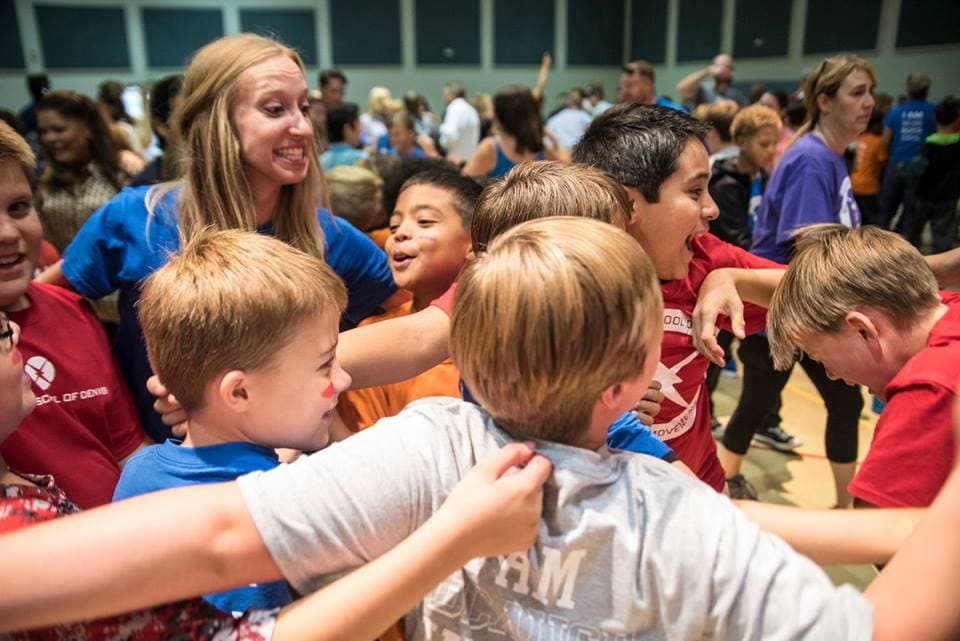
One of the first things the new sixth-graders at Denver’s new all-boys public school learned last week was the school cheer. And unlike what you might expect on the first day of a school that drew kids from 31 different elementary schools from all corners of the city — kids who were, for the most part, strangers in matching T-shirts — they were not at all timid.
The first time they tried the cheer, their voices boomed as loudly as tween boys’ voices can.
“I am!” school leader Nick Jackson shouted with the enthusiasm of a summer camp counselor.
“We are!” the boys answered in kind.
“I am!” “We are!”
“I am!” “We are!”
Two claps. Loud. “Boys School!”
In the seconds of silence that followed, Jackson held out his arm.
“Feel this! Feel this!” he said. “Those are goosebumps.”
The Boys School of Denver is one of five new schools opening this fall in Denver Public Schools (see box). The five schools are opening for a variety of reasons ranging from a need to accommodate a growing number of students in certain neighborhoods to a desire to provide families more high-quality options in a city that prizes school choice.
The school district’s first day was Monday but The Boys School, a charter with autonomy over its schedule as well as other aspects of its program, started a few days early.
On the first morning, 87 sixth-graders showed up to the massive campus of the Riverside Church in northwest Denver, where The Boys School is renting space this year. The school plans to add a grade each year until it eventually serves students in grades 6 through 12.
It’s a replication of sorts of Denver’s successful Girls Athletic Leadership School, an all-girls charter middle and high school. GALS, as it’s called, opened in 2010 with the aim of building girls’ self-esteem and sharpening their focus through physical movement and positive gender messages. That means starting the day with 45 minutes of movement, taking “brain breaks” during lessons, and requiring classes on deconstructing stereotypes in addition to academics.
The Boys School will follow the same model.
“For boys, they’re being pushed into being competitive or having a more assertive way about them,” said Carol Bowar, who is executive director of the organization. “We’re trying to neutralize that a bit to allow kids to develop and grow as who they are.”
A 2014 analysis of 184 studies from around the world found single-gender schools do not educate girls or boys better than co-ed schools. But Bowar points to other research on adolescent development, sex differences and how exercise can sharpen brain function, as well as GALS’s own results.
Last year, more GALS middle schoolers scored at grade level in English and math on state standardized tests than the districtwide averages. They also showed high academic growth; for instance, GALS middle schoolers scored better, on average, than 63 percent of Colorado students who had similar test scores the year before in math.
Leaders decided to open an all-boys school to offer the same opportunities to boys, Bowar said. Plus, she said, families with both sons and daughters repeatedly asked for one.
“We started hearing from year one, ‘I am so in love with your school for my daughter but I want it for my son,’” said Bowar, who herself has a sixth-grade son in the first class.
In a district where many schools are segregated by race, GALS has a more diverse student population than most. Last year, 55 percent of the 280 students at GALS middle school were students of color; 49 percent qualified for subsidized lunches, a proxy for poverty; 20 percent were English language learners; and 11 percent received special education.
Not all of those metrics are available yet for The Boys School. But Bowar provided some details: 57 percent of the sixth-graders registered before the first day of school were white, 28 percent were Latino, 11 percent were black, and 2 percent were Asian.
That’s fewer students of color than in the district as a whole. Overall, about 77 percent of DPS’s 92,000 students last year were students of color. About 23 percent were white.
GALS is also expanding outside Denver. A GALS middle school opened last year in Los Angeles, having been recruited there by a group of educators and community members. Educators in the Bay Area and Tucson are also interested in starting GALS schools, Bowar said. And the Los Angeles group plans to apply for a charter for a boys school, she said.
The Boys School is not Denver’s first-ever all-boys charter school. A previous all-boys charter with a different model, Sims-Fayola International Academy, closed in 2015 due to financial, logistical, and academic challenges.
After the assembly where they learned the school cheer, the inaugural Boys School sixth-grade class walked a couple blocks to a nearby city park blanketed by long grass that was still wet with morning dew. Jackson, who spent the previous three years at GALS, explained to them the rules of a game called Mighty Mighty Scoop Noodle Challenge.
Popular at the girls school, the game is similar to capture the flag. But instead of a single flag, players must steal several objects from the opposing team, including a foam pool noodle.
The boys split into two teams and lined up on opposite sides of a wide open field. When Jackson gave the signal, they ran toward each other with pre-adolescent abandon.
The first day of school was short on academics and packed with activities meant to help build a sense of belonging and brotherhood among the students, Jackson said, and to make the boys feel “well-held, comfortable, safe and like they’re a part of something.”
Too many kids, he said, are quick to abandon who they are in an attempt to fit in.
“We’re trying to change that,” Jackson said.
Chalkbeat is a nonprofit news site covering educational change in public schools.












